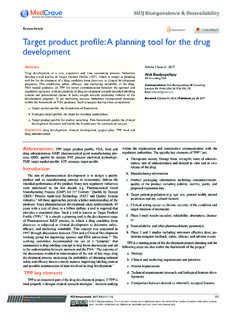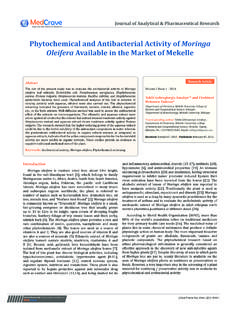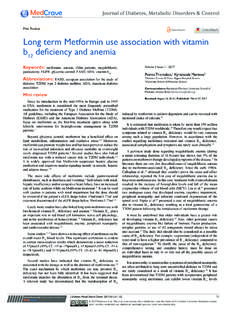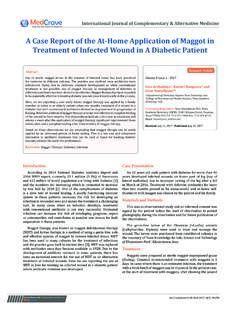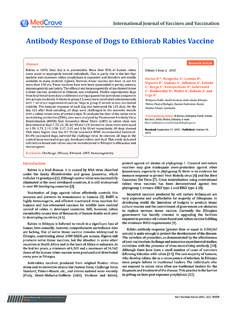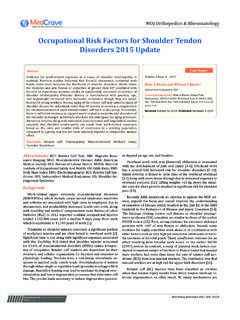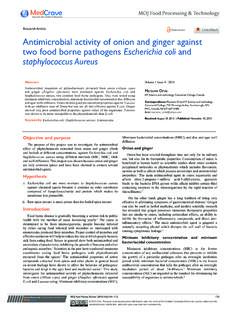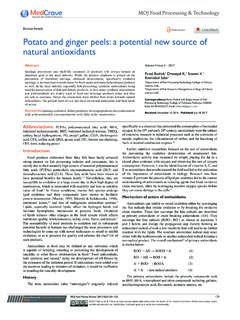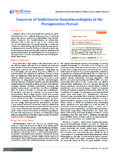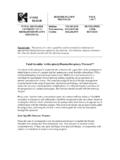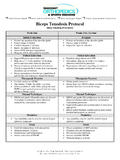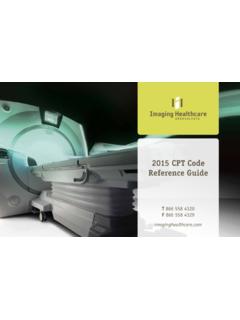Transcription of Irreparable Rotator Cuff Tears: Current Treatment …
1 MOJ Orthopedics & Rheumatology Irreparable Rotator cuff Tears: Current Treatment OptionsSubmit Manuscript | : CT: Computed Tomography; MRI: Magnetic Resonance Imaging; RCT: Rotator cuff tears; AHI: Acromio Humeral Interval; AP: Anterior Posterior; AC: Acromio Clavicular; NSAIDs: Non-Steroidal Anti-Inflammatory Drug; ECM: Extra Cellular Matrix; ASCR: Arthroscopic Superior Capsule Reconstruction; CTA: cuff Tear Arthropathy; RTSA: Reverse Total Shoulder ImplantIntroductionRotator cuff tears (RCT) are one of the most commonly treated orthopedic pathologies. Controversy exists with regard to the management of these injuries. Most surgeons agree that an acute painful tear in a young person should be treated operatively in order to decrease pain and provide satisfactory long-term function. However, great controversy exists with regard to tears that are large, chronic in nature, and not amenable to repair by standard means.
2 These tears, deemed Irreparable or massive , provide an ongoing challenge for the orthopedic surgeon. Authors have attempted to classify these tears based on their size and location [1]. Cofield et al. [2] described a massive tear as greater than 5cm2. Others consider a massive Rotator cuff tear to be one involving two or more tendons. Posterosuperior tears involve the supraspinatus and infraspinatus and are more common than anterosuperior tears, which involve the supraspinatus and subscapularis tendons. The size and reparability of a tear are not always related, nor are they mutually exclusive descriptions. A massive tear is not necessarily Irreparable and an Irreparable tear does not mean it is massive in size. However, an Irreparable tear can be defined surgically as a tear in which direct tendon-to-bone repair and healing is not possible. An Irreparable tear was described by Warner et al. [3] as the inability to achieve a direct repair of the native tendon to the humerus despite mobilizing the soft tissues [3].
3 Small chronic tears in contradistinction to massive tears may be small and friable and unable to be repaired primarily to bone. Goutallier et al. [4] described fatty degeneration of the Rotator cuff through CT scans and graded the muscle quality with grades 0-IV [4]. Irreparable Rotator cuff tears are usually large and retracted with nonfunctional muscle bellies and severe fatty degeneration. The true determination of an Irreparable cuff tear, however, is definitively performed under direct visualization during RCTs may occur through different mechanisms including acute ( traumatic), acute on chronic, and chronic ( degenerative) tears. Generally, acute massive tears greater than 5 cm are repairable, assuming fatty degeneration is minimal. However, an acute tear with thin friable tissue may be Irreparable if it is unable to be mobilized. Some studies have analyzed the acromiohumeral interval (AHI) to determine whether a RCT is repairable.
4 An AHI of less than 7 mm has been associated with decreased likelihood of a repairable tear [5]. Gerber et al. [6] showed that fatty infiltration in a sheep model of Rotator cuff tears is a necessary consequence following macro-architectural change rather than degenerative process [6]. As the tendon tears and the muscle retracts, the pennation angle of the muscle decreases, enabling the space between individual muscle fibers to become Volume 4 Issue 3 - 2016 Department of Orthopaedic Surgery, University of Southern California, USA*Corresponding author: Michael A Stone, Department of Orthopaedic Surgery, Keck School of Medicine, University of Southern California, 1200 N State St CT-A7D, Los Angeles, CA 90033, USA, Email: Received: December 06, 2016 | Published: January 29, 2016 Review ArticleMOJ Orthop Rheumatol 2016, 4(3): 00135 AbstractIrreparable Rotator cuff tears are a challenging problem facing orthopedic surgeons.
5 Multiple Treatment strategies have been proposed depending on patient factors such as age, activity, and the quality of the Rotator cuff tendon. The clinical presentation of a patient with an Irreparable Rotator cuff tear is variable with respect to pain, function, and disability, necessitating a thorough, detail-oriented clinical evaluation. Initial imaging should include plain radiographs and magnetic resonance imaging (MRI) to evaluate tendon quality. Computed tomography (CT) arthrography may be used if MRI is contraindicated. Non operative Treatment is generally reserved for low demand patients with minimal pain, while debridement, partial-repair, and subacromial decompression with or without biceps tenodesis versus tenotomy have been advocated in low demand patients with significant pain. However, these Treatment modalities often result in unpredictable and marginal improvements in functional outcomes.
6 Tendon transfers including the latissimus dorsi, pectoralis major, and trapezius muscles have been used to improve function. Scaffold devices have more recently been used as a biologic patch graft and augment. Superior capsule reconstruction is a novel technique that has been shown to restore glenohumeral stability. Reverse total shoulder arthroplasty and hemiarthroplasty can be used as salvage options in patients with Rotator cuff tear arthropathy. Keywords: Rotator cuff ; Irreparable Rotator cuff Tear; Tendon TransferIrreparable Rotator cuff Tears: Current Treatment Options2/6 Copyright: 2016 Stone et : Stone MA, Heckmann N, Omid R (2016) Irreparable Rotator cuff Tears: Current Treatment Options. MOJ Orthop Rheumatol 4(3): 00135. DOI: with fat. As the muscle retracts and becomes filled with fat, it becomes stiffer and less muscles of the Rotator cuff provide dynamic stability to the shoulder. EMG studies have demonstrated that the Rotator cuff muscles fire prior to deltoid activity which prepares the shoulder for movement by the periscapular muscles [7].
7 Burkhart described the force-couple concept of the Rotator cuff after performing fluoroscopic evaluations of patients with massive Rotator cuff tears. He stated that normal shoulder function is possible as long as there are balanced forces between the two force couples; the first force couple in the transverse plane (subscapularis and teres minor/infraspinatus), and the second force couple in the coronal plane (deltoid and inferior cuff ) [8].Clinical EvaluationIrreparable Rotator cuff tears are notoriously unpredictable with respect to their clinical presentation. The spectrum of pain and functional disability varies widely. A shoulder may function well in the setting of a painless tear, whereas a small painful tear may result in substantial shoulder dysfunction and disability. The physical exam should begin with inspection of both upper extremities with the shoulders exposed. The supraspinatus and infraspinatus fosse should be closely examined for signs of atrophy, which signify chronic involvement.
8 If the patient is able to maintain the 90-90 position with the shoulder abducted to 90 degrees and fully externally rotated, this generally excludes the diagnosis of an Irreparable tear and indicates an intact teres minor and infraspinatus [9]. The supraspinatus can be examined with resisted forward flexion in the plane of the scapula with the thumb turned towards the floor, while the infraspinatus is examined with resisted external rotation with the shoulder adducted. The subscapularis is assessed with multiple tests, including the abdominal compression test, lift off test, and bear hug test. The belly press test specifically tests the superior supraspinatus while the lift-off test specifically tests the lower subscapularis fibers [10]. Posterosuperior cuff tears are associated with a positive lag sign when the patients is unable to maintain the shoulder externally rotated at 90 degrees of abduction and adducted to the side. Imaging of the shoulder should include a standard set of four X-rays.
9 A true anterior-posterior (AP) view of the shoulder ( Grashey view) identifies pathology of the glenohumeral joint as well as superior migration of the humeral head. An AP view of the shoulder will identify acromioclavicular (AC) joint pathology, including sub luxation and degenerative changes. The axillary view assesses the position of the humeral head within the glenoid in the anterior-to-posterior direction. Anterior sub luxation of the head in this view may indicate an incompetent subscapularis. The scapular-Y view gives a clear view of the supra scapular outlet as well as the humeral head position relative to the glenoid. Acromial morphology is also clearly delineated on this view. The acromiohumeral interval (AHI) measures 7 to 14 mm in healthy shoulders on the standard shoulder AP, and may indicate Rotator cuff tear when the AHI falls below 5 mm [11]. MRI of the shoulder is useful for evaluating Rotator cuff tear as well as examining the muscle bellies on T1-weighted sagittal oblique cuts.
10 The Goutallier [4] classification is used for grading fatty degeneration of the Rotator cuff muscles and is useful in identifying Irreparable Rotator cuff tears. CT arthrography is useful in the setting of a contraindication to an MRI study [4]. Ultrasound has shown to be a valuable technique in detecting Rotator cuff tears, with moderate to excellent (72-100%) accuracy in detecting fatty degeneration [12]. Ultrasound, however, is highly operator dependent and is unable to penetrate bone. It is therefore less accurate in identifying large Rotator cuff tears retracted medial to the lateral acromial border [13]. Management OptionsNon operative treatmentNon operative Treatment for patients with an Irreparable RCT is generally reserved for low demand patients who are not experiencing significant pain. The mainstay of non operative management is physical therapy, subacromial injections, and non-steroidal anti-inflammatory drug (NSAIDs).
